AMD Radeon HD 7790 vs. Nvidia GeForce GTX 650 Ti BOOST

Two new graphics cards in the entry-level price segment entered into a fierce competition against each other. Who will come out on top?
In 2012 AMD and Nvidia, the two leading developers of GPUs for discrete graphics cards, did everything to present complete line-ups of new products to their users. Both were ready to offer a solution for any budget. Moreover, Nvidia has recently improved its standing in the top price segment by releasing the GeForce GTX Titan while AMD has answered with the dual-processor Radeon HD 7990. In this review we won’t talk about premium products but will focus instead on the most important entry-level market segment.
Until recently, AMD had a gap in its product range. The company offered the $110 Radeon HD 7770 GHz (Cape Verde XT processor) and the $190 Radeon HD 7850 (Pitcairn Pro) which differed by over 50% in performance. Of course, there existed a 1GB version of the Radeon HD 7850 at about $160 but it never became popular for some reasons. That’s why AMD has rolled out the Radeon HD 7790 with Bonaire processor at a price of $149-169. We’ll have a closer look at this product in a dedicated review. Today we’ll limit ourselves to checking out its performance level.
Nvidia’s line-up looks more balanced, without any gaps in performance and price. Despite this fact, the company has decided to meet the launch of the Radeon HD 7790 with a new product. It is called GeForce GTX 650 Ti Boost and it comes at a recommended $149 for a 1GB version or $169 for a 2GB version. Let’s see if these two new graphics cards are comparable to each other and how they stand in comparison with the HD 7770 and GTX 650 Ti on one hand and with the HD 7850 and GTX 660 on the other hand.
Technical Specifications
The specs of the AMD Radeon HD 7790 and NVIDIA GeForce GTX 650 Ti Boost are listed in the following table in comparison with those of the AMD Radeon HD 7850/7770 and NVIDIA GeForce GTX 660/650 Ti:
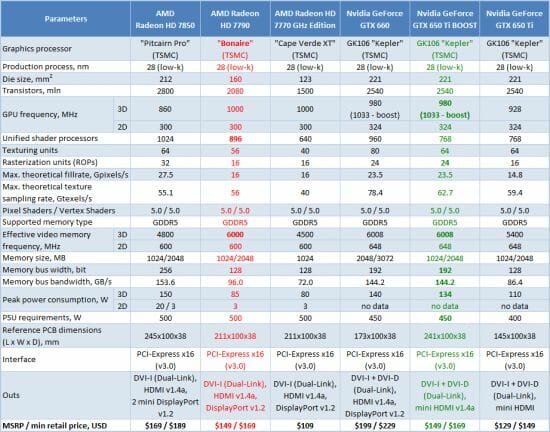
Testbed Configuration and Testing Methodology
All participating graphics cards were tested in a system with the following configuration:
- Mainboard: Intel Siler DX79SI (Intel X79 Express, LGA 2011, BIOS 0553 from 10/27/2012);
- CPU: Intel Core i7-3970X Extreme Edition, 3.5/4.0 GHz (Sandy Bridge-E, C2, 1.1 V, 2 x 256 KB L2, 15 MB L3);
- CPU cooler: Phanteks PH-TC14PE (2 x Corsair AF140 fans at 900 RPM);
- Thermal interface: ARCTIC MX-4;
- Graphics cards:
- HIS 7850 IceQ Turbo X 2 GB;
- Asus HD 7790 DirectCU II 1 OC GB (HD7790-DC2OC-1GD5);
- AMD Radeon HD 7770 GHz Edition 1 GB;
- Asus GeForce GTX 660 DirectCU II OC 2 GB;
- Nvidia GeForce GTX 650 Ti BOOST 2 GB;
- Gigabyte GeForce GTX 650 Ti 2 GB;
- System memory: DDR3 4 x 4GB Mushkin Redline (Spec: 2133 MHz / 9-11-10-28 / 1.65 V);
- System drive: Crucial m4 256 GB SSD (SATA-III,CT256M4SSD2, BIOS v0009);
- Drive for programs and games: Western Digital VelociRaptor (300GB, SATA-II, 10000 RPM, 16MB cache, NCQ) inside Scythe Quiet Drive 3.5” HDD silencer and cooler;
- Backup drive: Samsung Ecogreen F4 HD204UI (SATA-II, 2 TB, 5400 RPM, 32 MB, NCQ);
- System case: Antec Twelve Hundred (front panel: three Noiseblocker NB-Multiframe S-Series MF12-S2 fans at 1020 RPM; back panel: two Noiseblocker NB-BlackSilentPRO PL-1 fans at 1020 RPM; top panel: standard 200 mm fan at 400 RPM);
- Control and monitoring panel: Zalman ZM-MFC3;
- Power supply: Corsair AX1200i 1200 W (with a default 120 mm fan);
- Monitor: 27” Samsung S27A850D (DVI-I, 2560×1440, 60 Hz).
We’re already preparing two large reviews of off-the-shelf Radeon HD 7790 and GeForce GTX 650 Ti Boost, so today we’ll limit ourselves to their photos and specs.
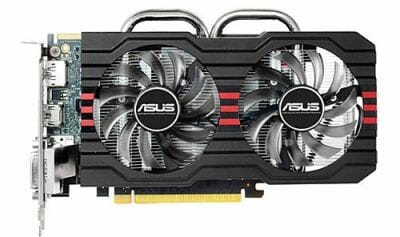
This ASUS card is pre-overclocked from 1000/6000 to 1075/6400 MHz, but we dropped its frequencies to the standard level for this testing. Moreover, we benchmarked our ASUS Radeon HD 7790 at highest frequencies we could achieve, namely 1220/6640 MHz.
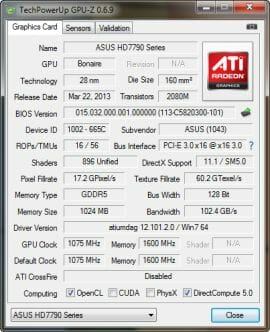
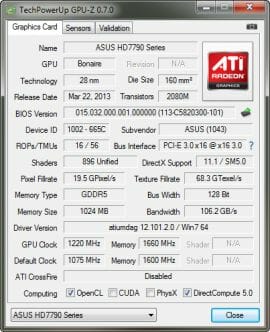
The reference Nvidia GeForce GTX 650 Ti Boost worked at the standard clock rates of 980/6008 MHz, so we didn’t do anything about its frequencies.
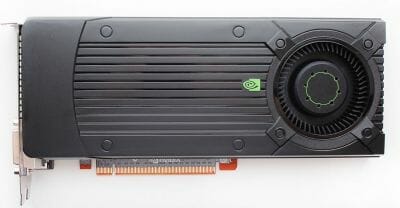
The overclocked card was stable at a GPU frequency of 1140 MHz (1193 in boost mode) and a memory frequency of 6648 MHz.
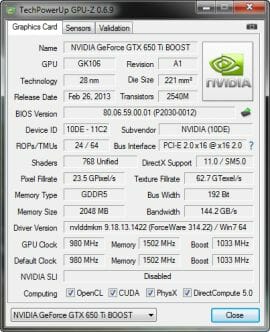
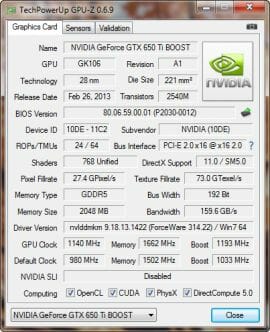
Besides competing with each other, the Radeon HD 7790 and GeForce GTX 650 Ti Boost will be compared with products of similar pricing. The Radeon HD 7850 is represented by a product from HIS whereas the Radeon HD 7770 GHz Edition is a reference card from AMD.
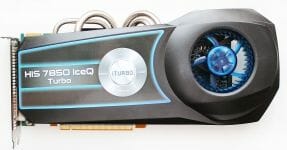
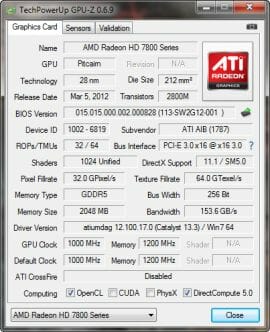
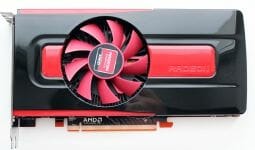
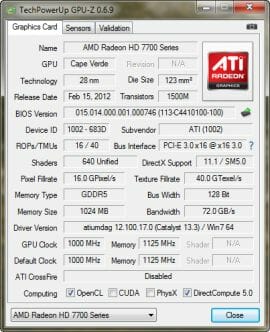
The screenshot of the HIS Radeon HD 7850 shows an increased GPU frequency but we dropped it to the standard level (840 MHz) for our testing.
The GeForce GTX 650 Ti Boost is bracketed in Nvidia’s hierarchy by the GeForce GTX 660, represented in this review by an ASUS product, and by the ordinary GeForce GTX 650 Ti which is represented by a Gigabyte card.
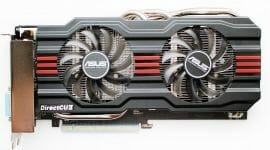
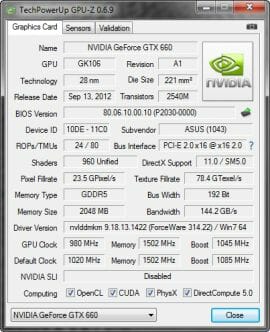
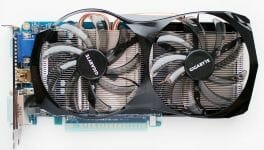
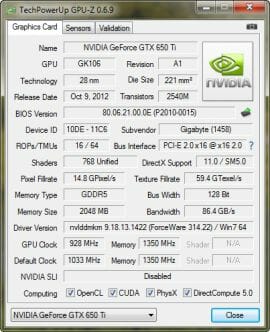
As you can see, we tested them at the standard clock rates.
In order to lower the dependence of the graphics cards performance on the overall platform speed, I overclocked our 32 nm six-core CPU with the multiplier set at 48x, BCLK frequency set at 100 MHz and “Load-Line Calibration” enabled to 4.8 GHz. The processor Vcore was increased to 1.385 V in the mainboard BIOS:
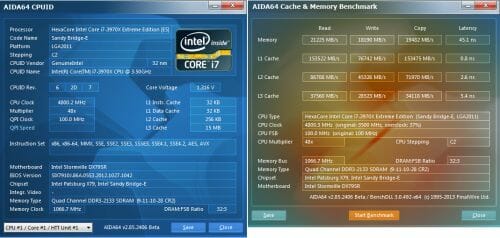
Hyper-Threading technology was enabled. 16 GB of system DDR3 memory worked at 2.133 GHz frequency with 9-11-10-28 timings and 1.65V voltage.
The test session started on March 31, 2013. All tests were performed in Microsoft Windows 7 Ultimate x64 SP1 with all critical updates as of that date and the following drivers:
- Intel Chipset Drivers 9.4.0.1017 WHQL from 02/07/2013 for the mainboard chipset;
- DirectX End-User Runtimes libraries from November 30, 2010;
- AMD Catalyst 13.3 Beta 3 driver from 03/20/2013 + Catalyst Application Profiles 12.11 (CAP2) for AMD based graphics cards;
- Nvidia GeForce 314.22 WHQL driver from 03/25/2013 for Nvidia based graphics cards.
Since we are discussing lower performance graphics cards, we only tested them in one resolution – 1920×1080. Lower resolutions start making less sense to look at because Full HD monitors are getting more and more affordable. The tests were performed in two image quality modes: “Quality+AF16x” – default texturing quality in the drivers with enabled 16x anisotropic filtering and “Quality+ AF16x+MSAA 4x” with enabled 16x anisotropic filtering and full screen 4x antialiasing. We enabled anisotropic filtering and full-screen anti-aliasing from the game settings. If the corresponding options were missing, we changed these settings in the Control Panels of Catalyst and GeForce drivers. We also disabled Vsync there. There were no other changes in the driver settings.
As usual, we expanded and updated out benchmarking suite. We removed Unigine Heaven benchmark, which is practically duplicating the newer Valley test. Moreover besides the previously added Resident Evil 6, Crysis 3 and Tomb Raider (2013), we also included such new gaming titles as StarCraft 2: Heart of the Swarm and BioShock Infinite. Of course, we haven’t forgotten about all the latest updates, which are current at the time of tests. As of today, out benchmarking suite includes two popular semi-synthetic benchmarks, one demo and 15 resource-consuming games of various genres:
- 3DMark 2011 (DirectX 11) – version 1.0.3.0, Performance and Extreme profiles;
- 3DMark 2013 (DirectX 9/11) – version 1.0, benchmarks in “Cloud Gate”, “Fire Strike” and “Fire Strike Extreme” scenes;
- Unigine Valley Bench (DirectX 11) – version 1.0, maximum image quality settings, AF16x and(or) MSAA 4x, 1980×1080 resolution;
- Resident Evil 6 Bench (DirectX 9) – version 1.0, all settings adjusted for maximum quality, FXAA3HQ antialiasing, Blur enabled, 1920×1080 and 2560×1440 resolutions;
- S.T.A.L.K.E.R.: Call of Pripyat (DirectX 11) – version 1.6.02, Enhanced Dynamic DX11 Lighting profile with all parameters manually set at their maximums, we used our custom cop03 demo on the Backwater map;
- Metro 2033: The Last Refuge (DirectX 10/11) – version 1.2, maximum graphics quality settings, official benchmark, “High” image quality settings; tesselation, DOF and MSAA4x disabled; AAA aliasing enabled, two consecutive runs of the “Frontline” scene;
- Aliens vs. Predator (2010) (DirectX 11) – Texture Quality “Very High”, Shadow Quality “High”, SSAO On, two test runs in each resolution;
- Total War: Shogun 2: Fall of the Samurai (DirectX 11) – version 1.1.0, built-in benchmark (Sekigahara battle) at maximum graphics quality settings and enabled MSAA 8x in one of the test modes;
- Crysis 2 (DirectX 11) – version 1.9, we used Adrenaline Crysis 2 Benchmark Tool v.1.0.1.14. BETA with “Ultra High” graphics quality profile and activated HD textures, two runs of a demo recorded on “Times Square” level;
- Battlefield 3 (DirectX 11) – version 1.4, all image quality settings set to “Ultra”, two successive runs of a scripted scene from the beginning of the “Going Hunting” mission 110 seconds long;
- Sniper Elite V2 Benchmark (DirectX 11) – version 1.05, we used Adrenaline Sniper Elite V2 Benchmark Tool v1.0.0.2 BETA with maximum graphics quality settings (“Ultra” profile), Advanced Shadows: HIGH, Ambient Occlusion: ON, Stereo 3D: OFF, two sequential test runs;
- Sleeping Dogs (DirectX 11) – version 1.5, we used Adrenaline Sleeping Dogs Benchmark Tool v1.0.0.3 BETA with maximum image quality settings, Hi-Res Textures pack installed, FPS Limiter and V-Sync disabled, two consecutive runs of the built-in benchmark with quality antialiasing at Normal and Extreme levels;
- F1 2012 (DirectX 11) – update 10, we used Adrenaline Racing Benchmark Tool v1.0.0.13 with “Ultra” image quality settings during two laps on Brazilian “Interlagos” race track with 24 other cars and a drizzling rain; we also used “Bonnet” camera mode;
- Borderlands 2 (DirectX 9) – version 1.3.1, built-in benchmark with maximum image quality settings and maximum PhysX level, FXAA enabled;
- Hitman: Absolution (DirectX 11) – version 1.0.446.0, built-in test with Ultra image quality settings, with enabled tessellation, FXAA and global lighting;
- Crysis 3 (DirectX 11) – version 1.0.1.3, all graphics quality settings at maximum, Motion Blur amount – Medium, lens flares – on, FXAA and MSAA4x modes enabled, two consecutive runs of a scripted scene from the beginning of the “Swamp” mission 110 seconds long;
- Tomb Raider (2013) (DirectX 11) – version 1.1.732.1, all image quality settings set to “Ultra”, V-Sync disabled, FXAA and 2x SSAA antialiasing enabled, TessFX technology activated, two consecutive runs of the benchmark built into the game;
- StarCraft II” Heart of the Swam (DirectX 10) – version 2.0.6.25180, texture quality settings at “Ultra”, all other image quality settings at maximum, two consecutive runs of the pre-recorded demo with a mass battle 110 seconds long;
- BioShock Infinite (DirectX 11) – version 1.1.21.26939, we used Adrenaline Action Benchmark Tool v1.0.2.1, two consecutive runs of the built-in benchmark with “Ultra” and “Ultra+DOF” quality settings.
If the game allowed recording the minimal fps readings, they were also added to the charts. We ran each game test or benchmark twice and took the best result for the diagrams, but only if the difference between them didn’t exceed 1%. If it did exceed 1%, we ran the tests at least one more time to achieve repeatability of results.
Performance
3DMark 2011
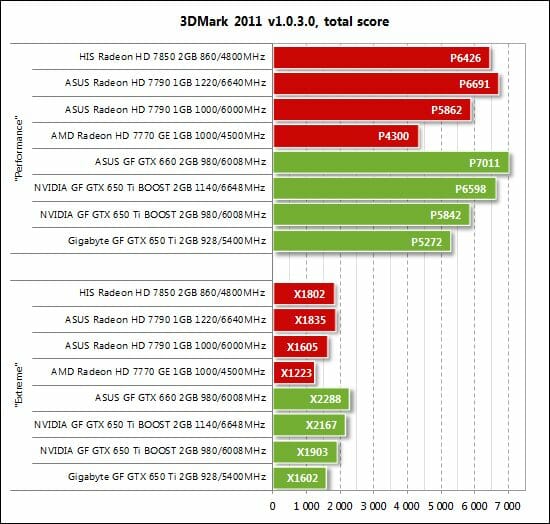
In 3DMark 2011 the new Radeon HD 7790 is 31-36% ahead of the Radeon HD 7770 GHz Edition and 9-11% behind the Radeon HD 7850, beating the latter in overclocked mode. Meanwhile, the GeForce GTX 650 Ti Boost is 11-19% faster than the ordinary GTX 650 Ti and 5-7% slower than the GTX 660. Comparing the two new products, the Radeon HD 7790 is somewhat better at the Performance settings but the GeForce GTX 650 Ti Boost is ahead at the Extreme settings.
3DMark 2013
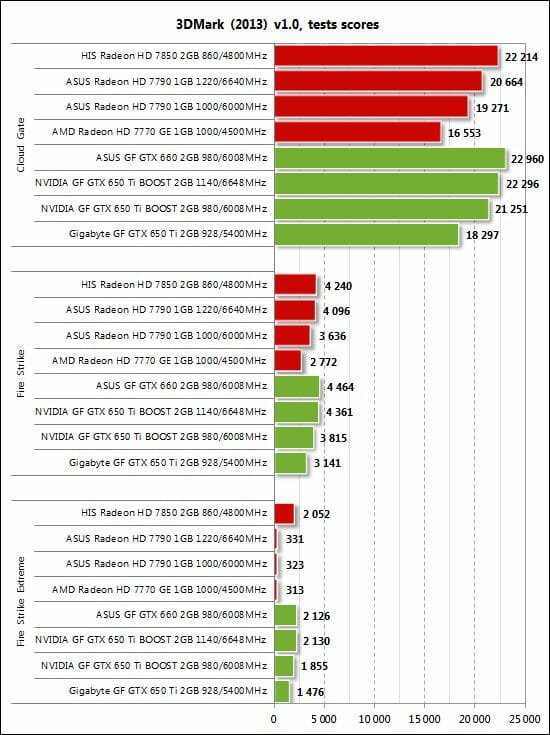
We can see the same picture in the first two test scenes from 3DMark 2013: the Nvidia products outperform same-class AMD solutions. The heaviest test Fire Strike Extreme highlights the weak side of the Radeon HD 7790, namely the small amount of its onboard memory, which leads to a performance hit. The GeForce GTX series cards all have twice the amount of memory and cope with Fire Strike Extreme much better.
Unigine Valley Bench
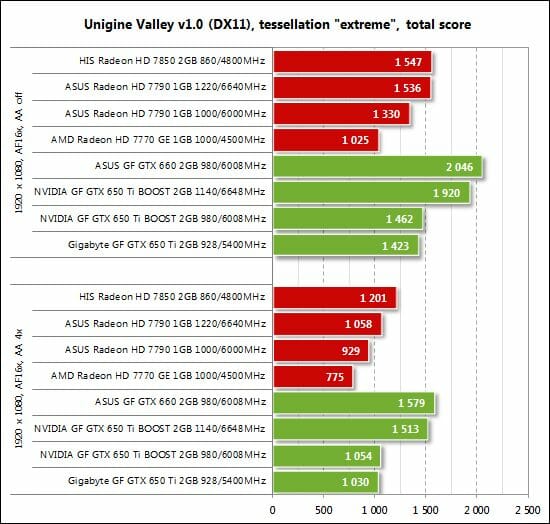
Although the new Radeon HD 7790 is up to 30% faster than its predecessor Radeon HD 7790 GHz Edition, the GeForce GTX 650 Ti Boost is faster still. The gap is especially impressive than both cards are overclocked.
Resident Evil 6 Bench
The GeForce GTX series is superior in the Resident Evil 6 benchmark, too:
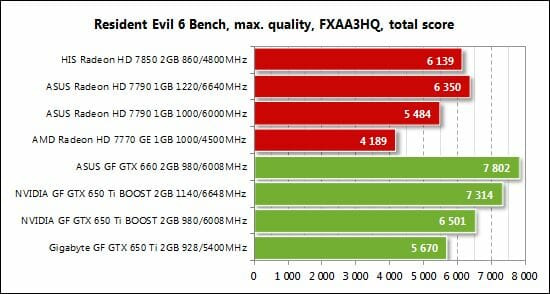
Now let’s move on to actual games.
>S.T.A.L.K.E.R.: Call of Pripyat
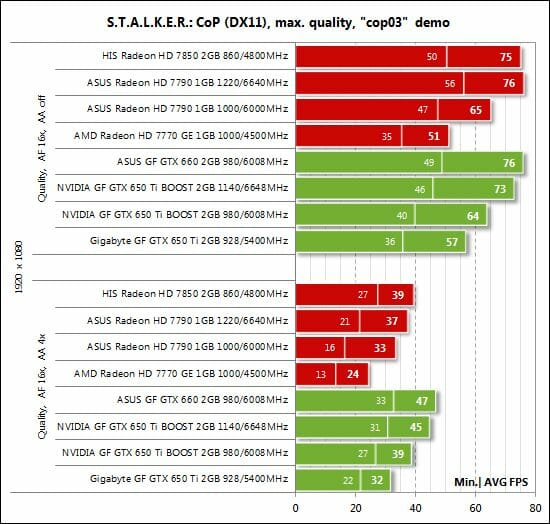
Same-class products from AMD and Nvidia are comparable in this game when we don’t use antialiasing. But as soon as we enable 4x MSAA, the Nvidia-based solutions go ahead. Take note that the Radeon HD 7790 and GeForce GTX 650 Ti Boost fit snugly in between the HD 7770 GHz Edition with HD 7850 and the GTX 650 Ti with GTX 660, respectively.
Metro 2033: The Last Refuge
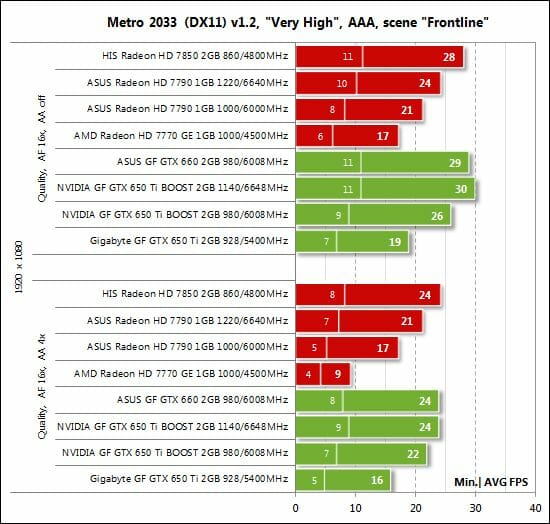
The new Radeon HD 7790 is in between the HD 7770 GHz Edition and the HD 7850 again whereas the GeForce GTX 650 Ti Boost beats it and even catches up with the GTX 660 when overclocked.
Aliens vs. Predator (2010)
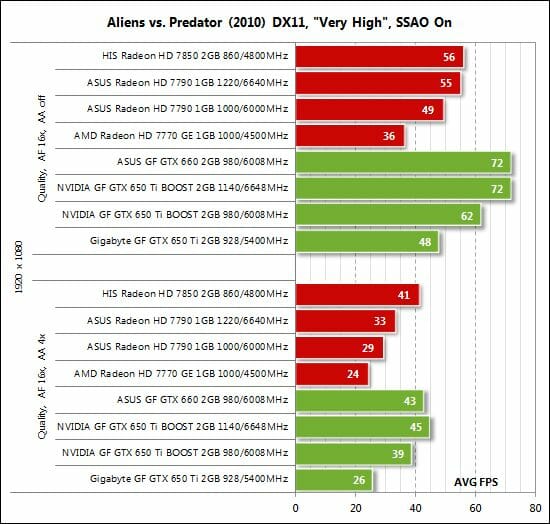
It’s like in the previous games but Nvidia enjoys a larger advantage.
Total War: Shogun 2 – Fall of the Samurai
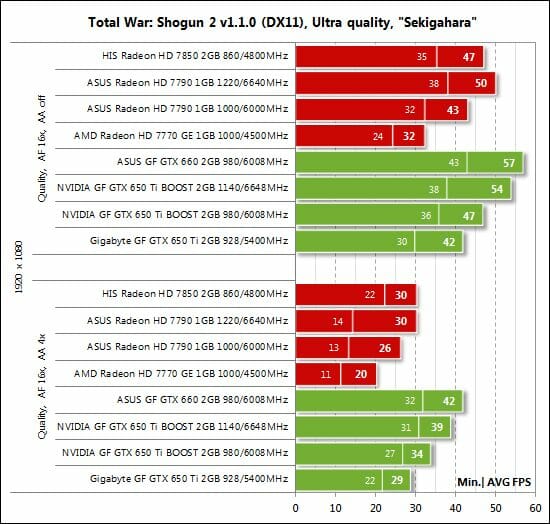
The new HD 7790 fills in the gap between the Radeon HD 7770 GHz Edition and HD 7860 in this game, too. But we have to note once again that the GeForce GTX 650 Ti Boost is preferable in terms of performance.
Crysis 2
The same goes for this test:
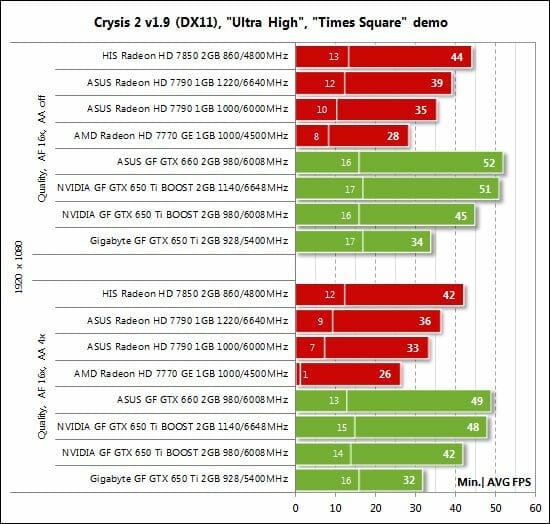
Battlefield 3
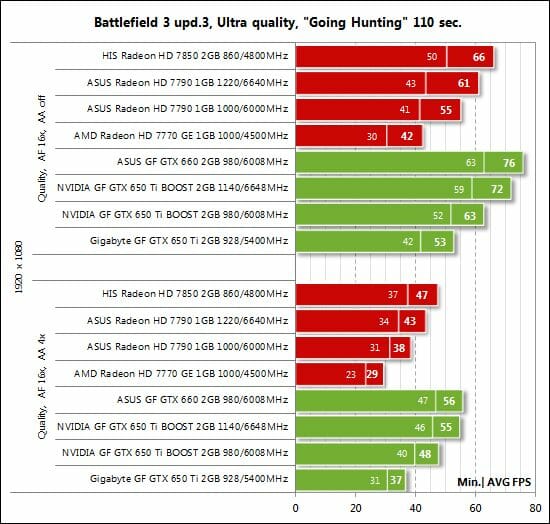
Judging by this and previous tests, the new Radeon HD 7790 seems to be in between the GeForce GTX 650 Ti and GTX 650 Ti Boost in terms of performance. It can only compete with the latter when overclocked.
Sniper Elite V2 Benchmark
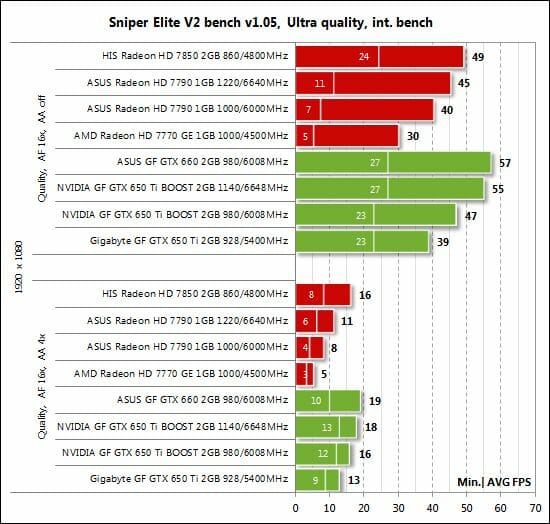
The Radeons are competitive against the opposing GeForce series cards in this game unless we turn on antialiasing. With 4x MSAA, the Radeon HD 7850 is the only card from AMD that looks good here. The 1GB products are too slow with 4x MSAA turned on.
Sleeping Dogs
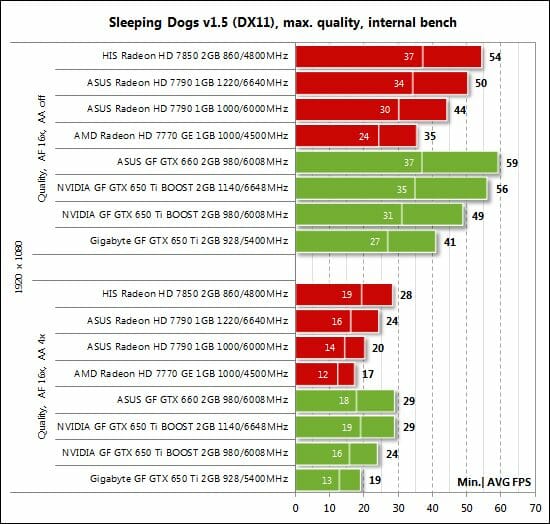
The Radeon HD 7790 is 18-26% faster than the HD 7770 GHz Edition and 19-29% slower than the Radeon HD 7850. In other words, it is exactly halfway between the two mentioned products. The GeForce GTX 650 Ti Boost is closer to its senior rather than junior cousin. The new Nvidia-based solution is obviously superior to the Radeon HD 7790.
F1 2012
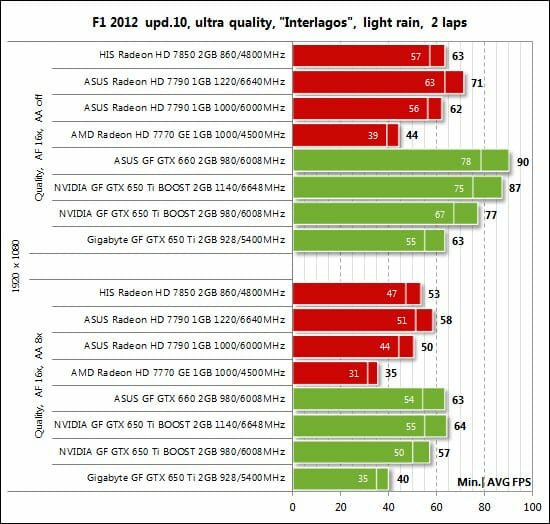
The Nvidia-based products look even more confident in this test. The Radeon HD 7790 beats the more expensive Radeon HD 7850 when overclocked.
Borderlands 2
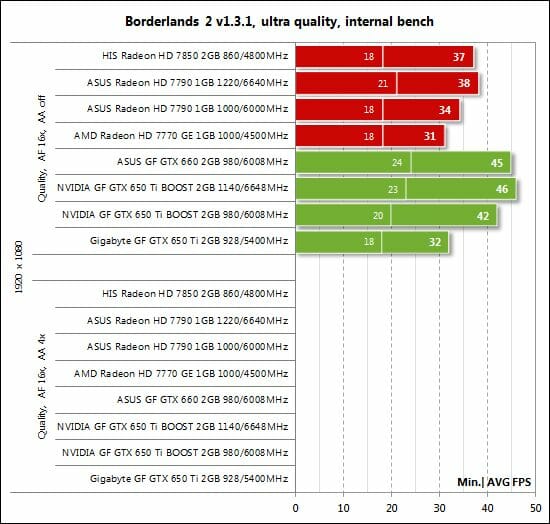
The Radeon HD 7790 fills the gap between the HD 7770 GHz Edition and the HD 7850 in this game as well. However, it cannot match the GeForce GTX 650 Ti Boost (in overclocked mode, too). The following two games produce the same picture.
Hitman: Absolution
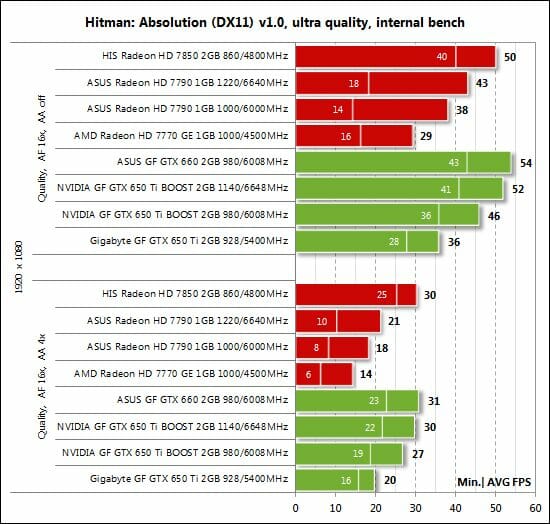
Crysis 3
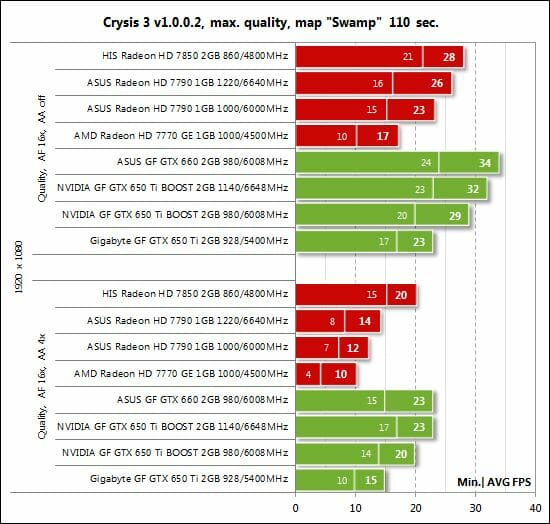
Tomb Raider (2013)
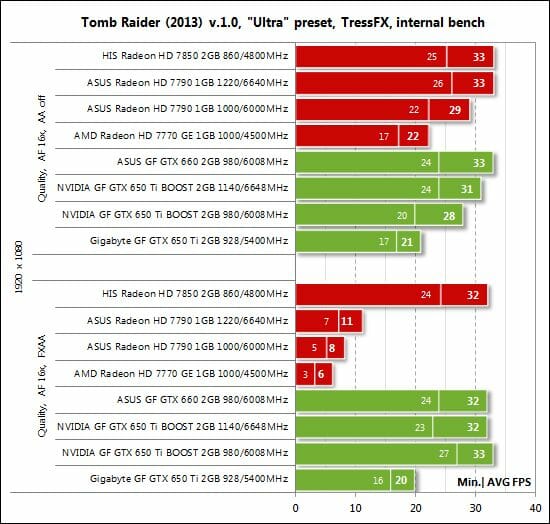
The Radeon HD 7790 performs poorly in the new Tomb Raider. When we enable such a light version of antialiasing as FXAA, it slows down along with the Radeon HD 7770 GHz Edition. It’s all because of the lack of graphics memory. This card surely needs 2 rather than 1 gigabyte of it.
StarCraft II: Heart of the Swarm
The lack of graphics memory is even more obvious here:
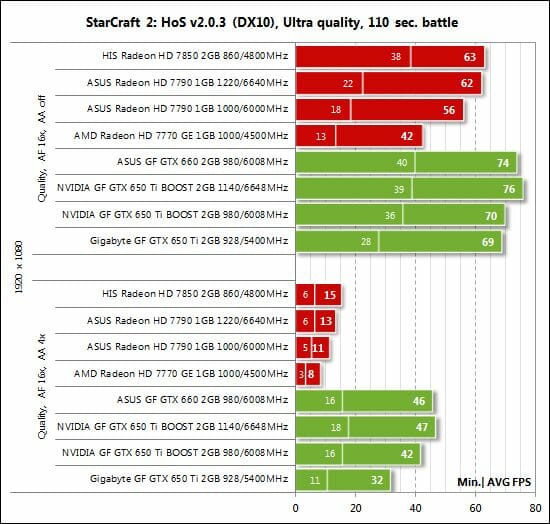
It must be noted, however, that every AMD-based graphics card has problems running this game with antialiasing turned on.
BioShock Infinite
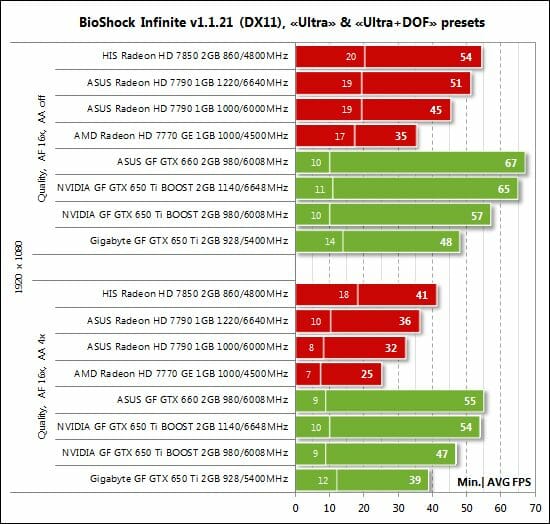
Every Nvidia-based card beats its AMD-based opponent from the same price category in BioShock Infinite.
Performance Summary
Here is a table with full test results, so we can proceed to our performance summary diagrams.
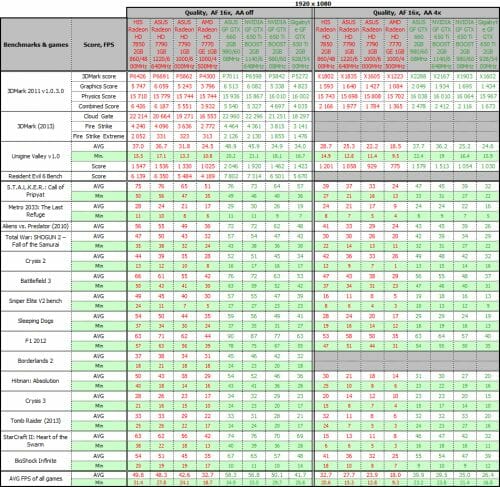
The first pair of diagrams shows the advantage of the Radeon HD 7790 1GB over the Radeon HD 7770 GHz Edition 1GB and the gap between it and the Radeon HD 7850 2GB.
As we can see, AMD developers and marketing folks have hit the target precisely. The Radeon HD 7790 is exactly halfway between the HD 7770 GHz Edition and the HD 7850 in terms of performance. As for specific numbers, the HD 7790 is an average 32% ahead of the HD 7770 GHz Edition across all games whereas the gap from the HD 7850 is about 30%. AMD should have released such a card long ago to fill in that gap in its product line-up.
Now let’s see how the Radeon HD 7790 compares to the default Radeon HD 7850 when clocked at 1220/6640 MHz.
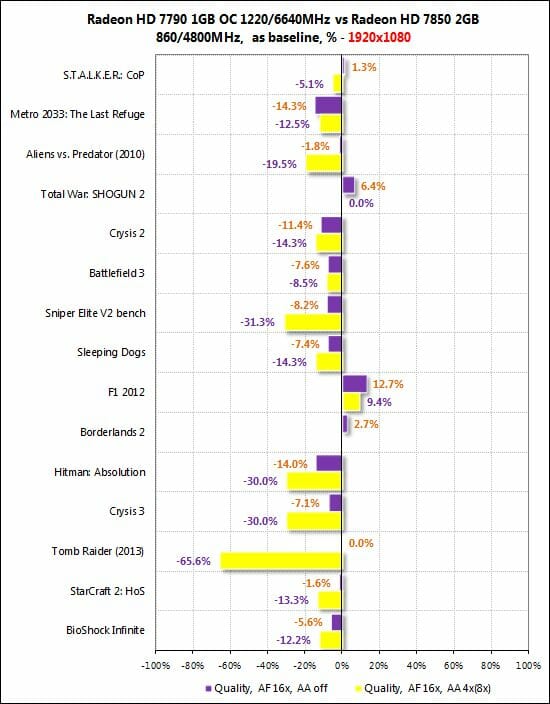
Our overclocking is quite rewarding, the Radeon HD 7790 being close to the next step in AMD’s product hierarchy. It is only in games that need more graphics memory that the increased clock rate can’t help bridge the gap, just as expected.
Now here’s the same pair of diagrams for the GeForce GTX 650 Ti Boost: in comparison with the ordinary GeForce GTX 650 Ti (on the right) and with the GeForce GTX 660 (on the left).
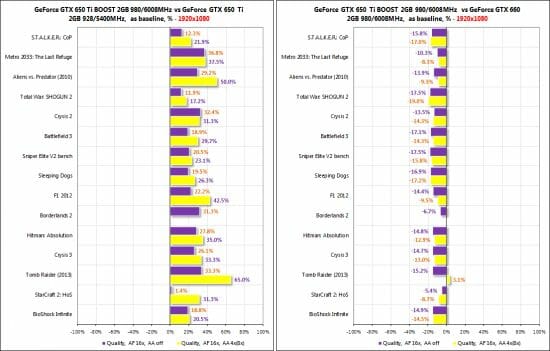
So, the boosted GTX 650 Ti is 22-33% ahead of the ordinary version, depending on the graphics quality settings, and falls 12-14% behind the GTX 660. Thus, the GeForce GTX 650 Ti Boost is closer to the GTX 660 rather than to the GTX 650 Ti. It is no wonder that it can beat the GTX 660 when overclocked:
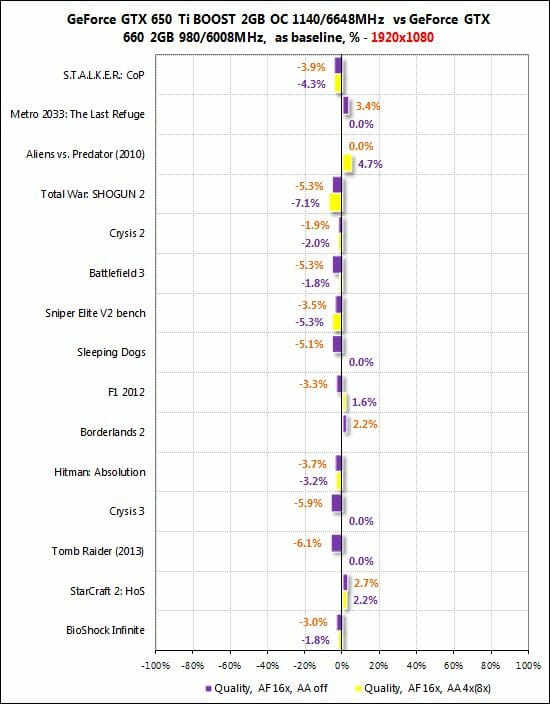
The next diagram compares the GeForce GTX 650 Ti Boost 2GB and the Radeon HD 7790 1GB, the latter serving as a baseline.
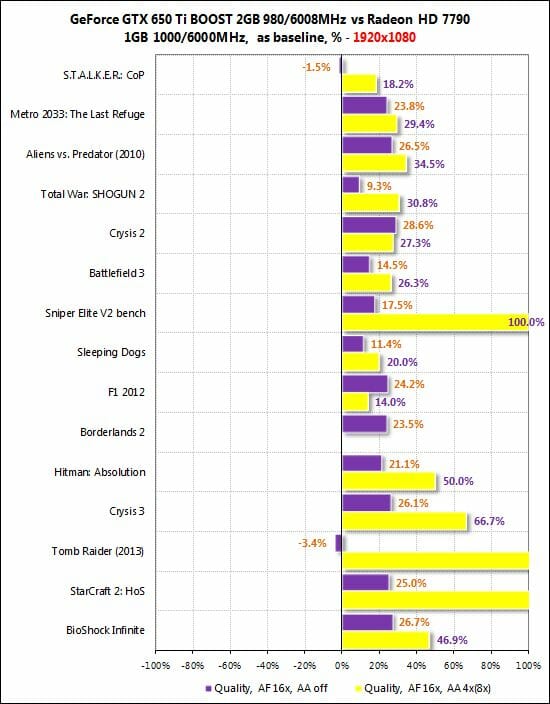
The two cards belong to the same product class, yet there’s a twofold difference in their memory amount and a $20 difference in price. Anyway, even if we don’t count in the low performance of the Radeon HD 7790 in certain games due to the lack of graphics memory, the GTX 650 Ti Boost is an average 18-33% faster, depending on graphics quality settings.
Power Consumption
We measured the power consumption of our testbed equipped with different graphics cards using a multifunctional Zalman ZM-MFC3 panel which can report how much power a computer (without the monitor) draws from a wall outlet. There were two test modes: 2D (editing documents in Microsoft Word or web surfing) and 3D (four runs of the introductory scene from the Swamp level in Crysis 3 game at 2560×1440 with maximum image quality settings, but without MSAA.
Let’s have a look at the diagram:
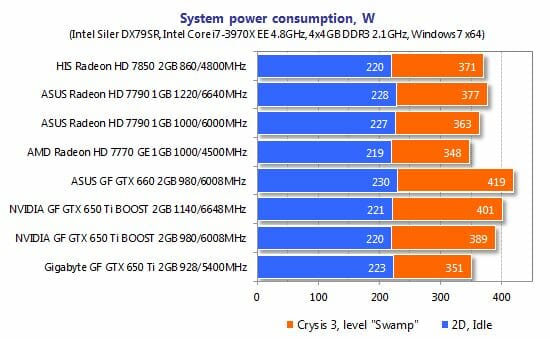
As we can see, our PC configuration with a rather fast CPU consumes less than 450 watts irrespective of the graphics card. As expected, the Radeon HD 7770 GHz Edition and GeForce GTX 650 Ti need more power than the others while the GeForce GTX 660 is the most economical. The differences between the graphics cards in terms of power draw are too small to affect your shopping choice, though.
Conclusion
As we’ve found out in our testing, the Radeon HD 7790 and the GeForce GTX 650 Ti Boost successfully complement the current line-ups of AMD- and Nvidia-based solutions. The former is exactly halfway between the Radeon HD 7770 GHz Edition and the Radeon HD 7850 while the latter is closer to the GeForce GTX 660 in performance. Both cards overclock well, the GeForce GTX 650 Ti Boost being even capable of accelerating to the speed of its senior cousin. Although the Radeon HD 7790 is positioned as an opponent to the GeForce GTX 650 Ti Boost considering their pricing, the Nvidia solution is faster, in some games even much faster. The Radeon HD 7790 is in between the ordinary GTX 650 Ti and the GTX 650 Ti Boost in sheer speed rather than competes with the latter. Moreover, we’d recommend you to buy a 2GB version of the Radeon HD 7790 which wouldn’t have problems at high settings, especially as the extra 1 gigabyte of memory doesn’t cost much.
That’s not the last of our reviews of these graphics cards. We’ll soon test a number of serially manufactured Radeon HD 7790 and GeForce GTX 650 Ti Boost. Stay tuned!